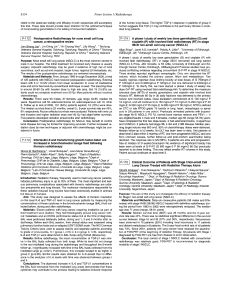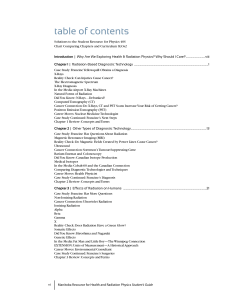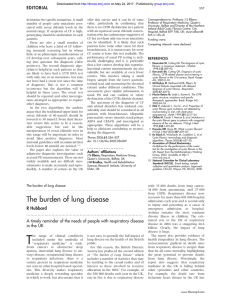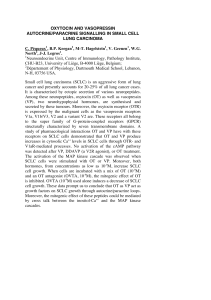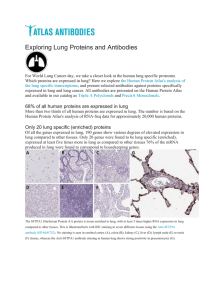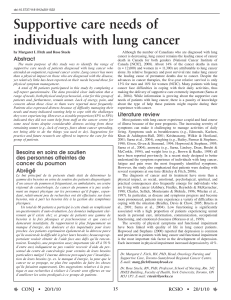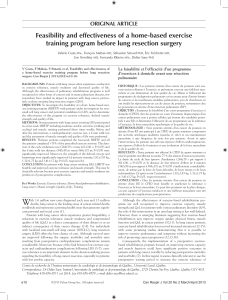NAVIGATION ÉLECTROMAGNÉTIQUE: POSSIBILITÉS ET LIMITES »
publicité
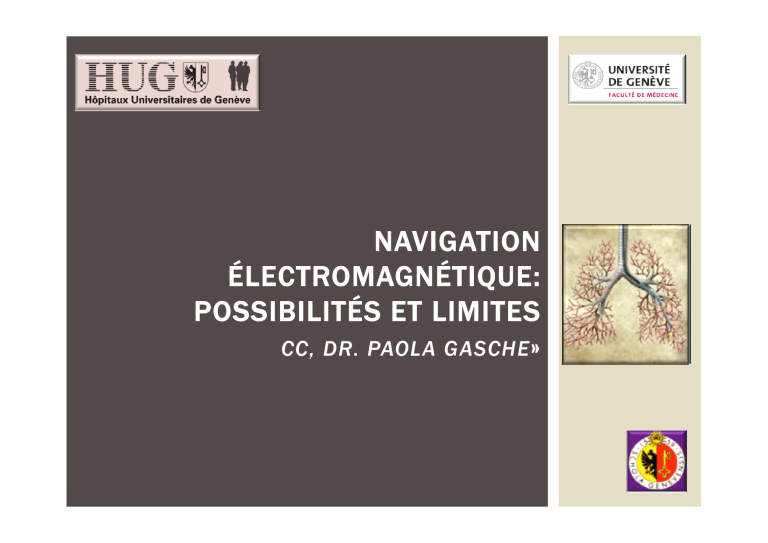
NAVIGATION ÉLECTROMAGNÉTIQUE: POSSIBILITÉS ET LIMITES CC, DR. PAOLA GASCHE » LUNG TERRITORY REACHABLE BY CONVENTIONAL BRONCHOSCOPY THE PROBLEM OF THE PERIPHERAL NODULE Peripheral nodule less than 2cm of diameter can be reached by conventional bronchoscopy only in 30% of cases (14% if in the outer ⅓ portion of lung parenchyma) Chest 2003;123:115S­128S. CONVENTIONAL APPROACH Ultra thin bronchoscope (2mm) and fluoroscopic guidance; 64.7% of sensitivity (Rooney CP, Respiration 2002;69:63­68) BIOPSY & RADIOLOGICAL GUIDANCE Guidance & fluoroscopy (Chest 2006;129:147­150) • Irradiation • Visibility ? 40% (54/138) of < 2.2cm lesions are not visible CT­scan trans­thoracic bx • From 65 to 90% of sensitivity depending on the type of lesion • Requires immobility of the patient during procedure • Risk of hemorrhage (10­20%) • Risk of pneumothorax (>30%) PNEUMOTHORAX RISK OF TTNA Ï with number of passes 37% one pass; 57% five passes Ïwith distance from pleura 15% 0 cm (pleura based); 50% 0‐5 cm Ð with lesion size 0‐2 cm = 50%; 2‐4 cm = 35%; >4 cm = 15% Ïwith presence of emphysema With emphysema = 50% (chest tube 27%) Without emphysema = 35% (chest tube 9%) Sources: Cox et al. Radiology July 1999;212:165-168 NODULE = REAL PROBLEM? Procedure Approx. #/year Hospital Days Reimbursement Performed by Diagnostic Bronchoscopy 3,500,000 1 $1,700 Interventional Pulmonologist Therapeutic Bronchoscopy 200,000 1-4 Up to $5,000 Interventional Pulmonologist CT-Guided Needle Biopsy 700,000 1 Up to $4,500 Interventional Radiologist Open Surgery 1,000,000 6 Up to $70,000 Surgeon Interventional Pulmonary procedures (Europe / N. America / Asia ~30% each) ELECTROMAGNETIC NAVIGATION SYSTEM Based on regular GPS system COMPONENTS OF THE SYSTEM 1. Magnetic field; the board COMPONENTS OF THE SYSTEM 2. Magnetic field: electrodes COMPONENTS OF THE SYSTEM 3. Sensor • • • Receptor of EM wave Position detected in 3 axes by software (X, Y, Z-axes, roll, pitch & yaw) Position shown on a monitor at a rate of 161 images/sec. COMPONENTS OF THE SYSTEM 3. The guide • 4 wires •Rotating handle •8 positions PROCEDURE Pre‐specified thoracic Ct‐scan data (Dicom CD) Ö Upload of the images in the navigation system Ö Route planning PROCEDURE 3‐D reconstruction & virtual bronchoscopy Choice of the target (1 or more) Choice of the pathway to the target PROCEDURE Synchronisation of the virtual with the real bronchoscopy Images (FB 2.8mmm) Navigation toward target PROCEDURE Navigation toward target(s) with steerable catheter inserted in a working channel PROCEDURE Navigation toward target(s) with steerable catheter inserted in a working channel PROCEDURE: TISSUE SAMPLING Once the target is reached: • Lock working channel • Remove steerable navigation catheter • Use instruments to remove tissue samples ENB ( E L E C T R O M A G N E T I C N AV I G AT I O N B R O N C H O S C O P Y ) ROSE : Rapid On Site Evaluation MODIFICATION OF ENB PERFORMANCE ENB(inReach TM ): N=104 RESULT S SENSITIVIT Y FOR MALIGNANCY ELECTROMAGNETIC NAVIGATION BRONCHOSCOPY (ENB) ALLOWS YOU TO: Navigate Navigate to distal lesions for biopsy Stage Stage lymph nodes Place Place fiducial markers for radiation treatment Locate Place markers to facilitate VATS Deliver Guide high dose radiation catheters TRANSBRONCHIAL PLACEMENT OF FIDUCIAL MARKERS USING ENB TRANSBRONCHIAL PLACEMENT OF FIDUCIAL MARKERS USING ENB superDimension® superLock® Bands (13‐23mm: 3mm gold) superDimension® superLock® Coils (5‐10‐20mm, 0.9, gold) superDimension® superLock Cobra® Fiducial Marker (7mm : Nitinol & gold seed 3.5x0.8) Stereotactic Body Radiotherapy (SBRT/SRT) • Uses a combination of precise patient positioning/immobilization to administer radiation with extreme accuracy • Increasingly being used to treat patients with early‐stage NSCLC who are not candidates for surgical resection or refuse surgery SBRT IN EARLY STAGE LUNG CANCER • Studies show a 5‐year survival rate of 50% for early stage lung cancer patients that are inoperable or refuse surgery 1‐4 • Early data shows comparable results to surgery with acceptable toxicity and comparable local control and survival rates 5‐8 SOURCES: 1) Sibley GS. (1998) Radiotherapy for patients with medically inoperable Stage I non­small cell lung carcinoma. Smaller volumes and higher doses: a review. Cancer 82:433‚Äì 438. 2)Armstrong JG, et al. (1989) Radiation therapy for medically inoperable stage I and II non­small cell lung cancer. Cancer Treat Rev. 16(4):247­255. 3) Dosoretz DE, et al. (1996) Medically inoperable lung carcinoma: the role of radiation therapy. Semin Radiat Oncol. 6(2):98­104. 4) Kaskowitz L, et al. (1993) Radiation therapy alone for stage I nonsmall cell lung cancer. Int J Radiat Oncol Biol Phys. 27(3):517­523. 5) Timmerman R; et al. (2010) Stereotactic Body Radiation Therapy for Inoperable Early Stage Lung Cancer JAMA 303(11):1070­1076. 6) Nagata Y, et al. (2005) Clinical outcomes of a phase I/II study of 48 Gy of stereotactic body radiotherapy in 4 fractions for primary lung cancer using a stereotactic body frame. Int J Radiat Oncol Biol Phys. 63(5):1427­1431. 7) Timmerman R, et al. (2006) Excessive toxicity when treating central tumors in a phase II study of stereotactic body radiation therapy for medically inoperable early­stage lung cancer. J Clin Oncol. 24(30):4833­4839. 8) Lagerwaard FJ,et al. (2008) Outcomes of risk­adapted fractionated stereotactic radiotherapy for stage I non­small­cell lung cancer. Int J Radiat Oncol Biol Phys. 70(3): 685­692. COMMON SBRT/SRT SYSTEMS • Novalis Tx® • TomoTherapy HiArt® • Varian Trilogy® • Varian TrueBeam® • Elekta Synergy® • Elekta Axesse® • Siemens Primatom® • Accuray CyberKnife® SBRT/SRT USES • Primary Treatment Modality – Curative – Inoperable patients (COPD, ILD) – Patients who refuse surgery • (Neo) Adjuvant Treatment – Pre‐operative treatment for subsequent surgical curative intent (Stage IIIA disease) • Palliative Treatment Motion Management is Critical to SBRT • Lung targets are dynamic • Failure to manage motion may result in inaccurate dose delivery • Preserves normal lung tissue Problems of Respiratory Motion • Causes artifact during imaging acquisitions • Target shape and volume uncertainty due to CT artifact • Dose uncertainty if motion is not accounted for Motion varies markedly between patients, indicating that an individual approach to respiratory management is required in SBRT RESPIRATORY GATING Defined as a specific window in the breathing cycle, much like a baseball strike zone, when it is optimal to turn on the radiation beam. Ideally, this "strike zone" is a period of time in the breathing cycle when the tumor moves the least. RESPIRATORY TRACKING Defined as delivering tightly contoured beams that move precisely with tumor motion throughout the respiratory cycle. ABDOMINAL COMPRESSION Defined as using a compression board to help minimize tumor motion during breathing cycles. FIDUCIAL MARKERS FOR LUNG SBRT/SRT Localization with fiducial markers directly into and/or around a lung tumor is considered an accurate way to aid respiratory motion management when delivering SBRT/SRT. IMPORTANCE OF FIDUCIAL MARKERS FOR AIDING MOTION MANAGEMENT Allows synchronization of patient’s anatomy from imaging to radiation delivery, accounting for respiratory motion Allows smaller/conformal radiation fields; less radiation to adjacent critical structures, higher doses to primary tumors and potentially better control Internal fiducial markers are a better surrogate of tumor motion compared to an external marker FIDUCIAL PLACEMENT USING ENB Planning Phase Target selected with planning software Navigation Using navigation catheter under electromagnetic guidance Marker Placement – Several Methods Stereotactic Radiotherapy Procedure Proceeds THE ENB SOLUTION – CLINICAL DATA Six (6) articles published on transbronchial placement of fiducial markers using ENB 1­6 • • • • Fiducial markers successfully placed in over 80 patients 2‐5 markers placed per tumor Lesion size varied from 0.8 cm to 6.5 cm in diameter Minimal migration and pneumothoracies reported SOURCES: 1) Harley, D, et al. Fiducial Marker Placement Using Endobronchial Ultrasound and Navigational Bronchoscopy for Stereotactic Radiosurgery: An Alternative Strategy. Ann Thorac Surg 2010; 89:368­374. 2) Schroeder, C, et al. Coil Spring Fiducial Markers Placed Safely Using Navigation Bronchoscopy in Inoperable Patients Allows Accurate Delivery of CyberKnife Stereotactic Radiosurgery J Thorac Cardiovasc Surg; 140:1137­1142. 3) Andrade, R. Seminars in Thoracic and Cardiovascular Surgery 2010; Vol 22, No 3. 4) Anatham, D, et al. Electromagnetic Navigation Bronchoscopy Guided Fiducial Placement for Robotic Stereotactic Radiosurgery of Lung Tumors – A Feasibility Study. Chest 2007; 132:930­935. 5) McGuire, F, et al. Radiotherapy Monitoring Device Implantation into Peripheral Lung Cancers: A Therapeutic Utility of Electromagnetic Navigational Bronchoscopy. Jrl of Bronch 2007; 14(3): 173­176. 6) Kupelian, P, et al. Implantation and Stability of Metallic Fiducials within Pulmonary Lesions. J Radiation Oncology Biol Phys 2007; 69(3): 777­785. CONCLUSIONS 1. Effective diagnostic technique • Successful diagnosis of peripheral lesions in 69‐82% of cases • No association with size of nodule • Probable even higher success rates for lymph nodes 2. Safe diagnostic technique • Pneumothorax rate of 0‐2.3% • No need for irradiation • Short learning curve 3. New option for SBRT/SBT









